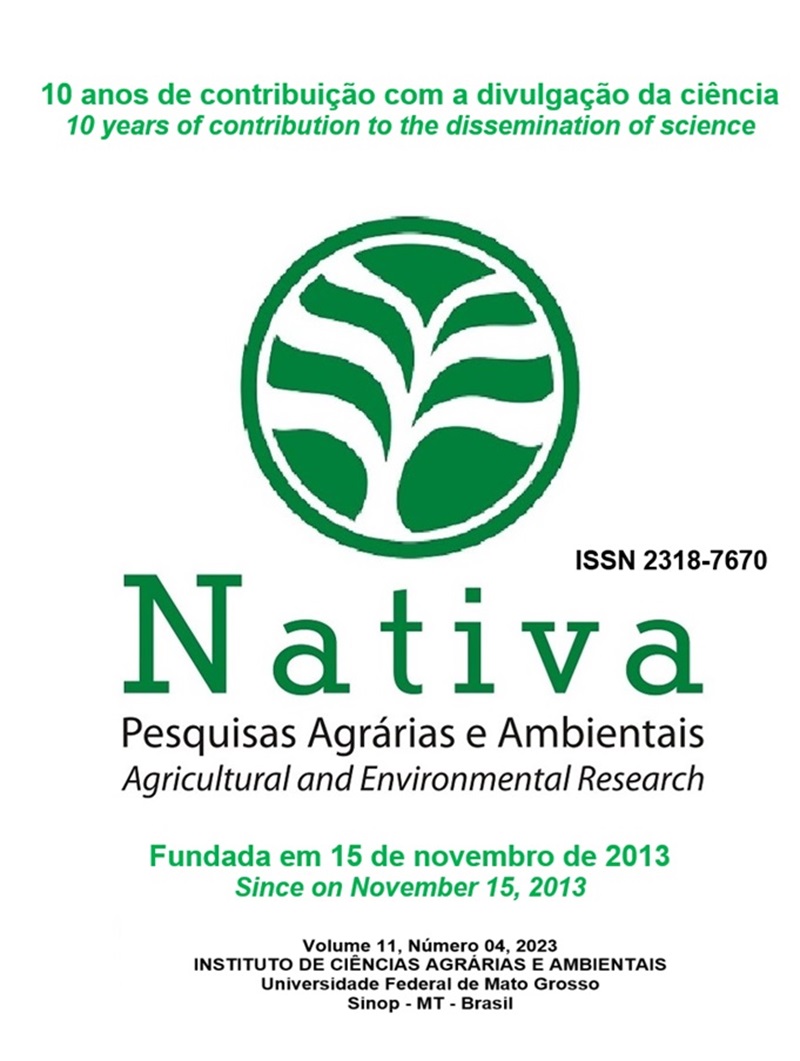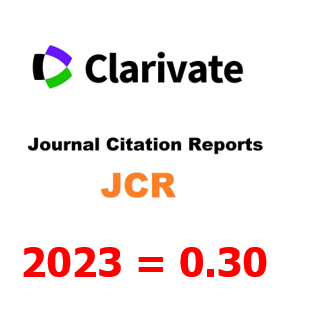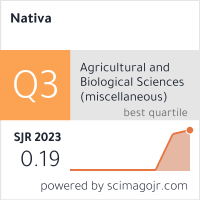EFEITO DO AMBIENTE SECO E CHUVOSO SOBRE O COMPORTAMENTO E PRODUÇÃO DE VACAS LEITEIRAS
DOI:
https://doi.org/10.31413/nat.v11i4.13927Palavras-chave:
temperatura retal, termólise,, ambiênciaResumo
Avaliou-se as condições bioclimáticas de produção e as respostas dos animais sob produção na região Meio Norte do Brasil. Vacas leiteiras em lactação, cruzadas (Gir x Holandês) e zebuínas (Gir) durante o período de secas e de chuvas. Coletados dados de temperatura do ar em bulbo seco e húmido, temperatura mínima e máxima, humidade relativa; frequência respiratória (FR), frequência cardíaca (FC) e temperatura retal (TR) convergiram para indicador bioclimático Indice de Temperatura e Umidade (ITU) e o indicador etológico Coeficiente de Tolerância ao Calor (CA). Análise de variância para aferir diferenças significativas acompanhadas de análises de post-hoc indicam efeitos significativo (p-valor ≤ 0,05) dos efeitos de época (Chuvas e Secas) e/ou de grupo genético (Girolanda/Gir). Identificou-se maiores temperaturas (T) e menores humidade relativas (UR) durante as secas: 30,5º e 47,5%; em relação ao período de chuvas: 26,7º C e 86,5%. A condições bioclimáticas estiveram majoritariamente inadequadas à bovinos. As respostas etológicas variaram principalmente em função de raça e somente a FC foi significativamente diferente em função de época. Animais Gir apesar de dispõem de menor perímetro torácico (PT) são mais hábeis em promover a termólise e/ou produzem menos calor endógeno, apresentando CA, FR, FC e TR significativamente (p-valor < 0,05) menores. As condições de produção são desafiadoras com alto ITU e respostas animais que indicam desconforto, principalmente durante os períodos de secas na região meio norte.
Palavras-chave: temperatura retal; termólise; ambiência.
Effect of dry and rainy environments on the Ethology of dairy cows
ABSTRACT: Bioclimatic production conditions and the responses of animals under production were evaluated in the Meio Norte region of Brazil. Lactating dairy cows, crossbreeds (Gir x Holstein) and zebu (Gyr) during the dry and rainy season. Collected air temperature data in the dry and wet bulbs, minimum and maximum temperature, relative humidity, respiratory rate (RR), heart rate (HR), and rectal temperature (TR) converged to the bioclimatic indicator Temperature and Humidity Index (THI) and the etiological indicator Heat Tolerance Coefficient (CA). Analysis of variance to assess significant differences accompanied by post-hoc analyses indicate significant effects (p-value ≤ 0.05) of season effects (Rains and Droughts) and/or genetic group (Girolanda/Gir). Higher temperatures (T) and lower relative humidity (RH) were identified during droughts: 30.5º and 47.5%; in relation to the rainy season: 26.7º C and 86.5%. Bioclimatic conditions were mostly unsuitable for cattle. Ethological responses varied mainly depending on breed and only HR significantly differed depending on season. Gir animals, despite having a smaller thoracic perimeter (PT), are more adept at promoting thermolysis and/or producing less endogenous heat, presenting significantly lower AC, RR, HR, and TR (p-value < 0.05). Production conditions are challenging with high THI and animal responses that indicate discomfort, especially during dry periods in the Meio Norte region.
Keywords: rectal temperature; thermolysis; ambiance.
Referências
DA COSTA, A. N. L; FEITOSA, J. V.; MONTEZUMA JR, P. A.; SOUZA, P. T. de; ARAÚJO, A. A. Rectal temperatures, respiratory rates, production, and reproduction performances of crossbred Girolando cows under heat stress in northeastern Brazil. International Journal of Biometeorology, v. 59, p. 1647-1653, 2015. https://doi.org/10.1007/s00484-015-0971-4
DE-SOUSA, K. T.; DENIZ, M.; DITTRICH, J. R.; HÖTZEL, M. J. Effects of tree arrangements of silvopasture system on behaviour and performance of cattle: a systematic review. Annals of Animal Science, v. 23, n. 3, p. 629-639, 2023. https://doi.org/10.2478/aoas-2023-0002
DIKMEN, S.; HANSEN, P. J. Is the temperature-humidity index the best indicator of heat stress in lactating dairy cows in a subtropical environment? Journal of Dairy Science, v. 92, n. 1, p. 109-116, 2009. https://doi.org/10.3168/jds.2008-1370
DINIZ, T. A.; CARVALHO, C. da C. S.; FERREIRA, H. C.; CASTRO, A. L. de O.; PEREIRA, K. C. B.; GONÇALVES, M. C. M.; SOARES, T. E.; MENEZES, J. C. Vacas F1 Holandês x Zebu no terço final de gestação apresentam adaptação fisiológica quando criadas no ambiente semiárido. Revista de Ciências Agroveterinárias, v. 16, n. 1, p. 70-75, 2017. https://doi.org/10.5965/223811711612017070
FERRAZZA, R. de A.; CASTELLANI, E. Analysis of Brazilian livestock transformations: a focus on dairy farming. Ciência Animal Brasileira, v. 22, e68940, 2022. https://doi.org/10.1590/1809-6891v22e-68940
FERREIRA, R. A. Maior produção com melhor ambiente para aves, suínos e bovinos. Viçosa: Aprenda Fácil, 2005. 371p.
GALÁN, E.; LIONCH, P.; VILLAGRÁ, A.; LEVIT, H.; PINTO, S.; DEL PRADO, A. A systematic review of non-productivity-related animal-based indicators of heat stress resilience in dairy cattle. PloS One, v. 13, n. 11, p. e0206520, 2018. https://doi.org/10.1371/journal.pone.0206520
ERBUT, P.; HOFFMANN, G.; ANGRECKA, S.; GODYN, D.; VIEIRA, F. M. C.; ADAMCZYK, K.; KUPCZYNSKI, R. The effects of heat stress on the behavior of dairy cows–a review. Annals of Animal Science, v. 21, n. 2, p. 385-402, 2021. http://dx.doi.org/10.2478/aoas-2020-0116
INMET_Instituto Nacional de Metereologia. Consulta Dados da Estação Automática: Teresina (PI) estação “Teresina-A312. Disponível em:< http://www.inmet.gov.br/portal/index.php?r=estacoes/estacoesAutomaticas>. Acessado em 11 de outubro de 2020.
KAUFMAN, J. D.; SAXTON, A. M.; RÍUS, A. G. Relationships among temperature-humidity index with rectal, udder surface, and vaginal temperatures in lactating dairy cows experiencing heat stress. Journal of Dairy Science, v. 101, n. 7, p. 6424-6429, 2018. https://doi.org/10.3168/jds.2017-13799
LEES, J. C.; LEES, A. M.; GAUGHAN, J. B. The influence of shade availability on the effectiveness of the Dairy Heat Load Index (DHLI) to predict lactating cow behavior, physiology, and production traits. International Journal of Biometeorology, v. 66, n. 2, p. 289-299, 2022. https://doi.org/10.1007/s00484-021-02186-x
LIU, J.; LI, L.; CHEN, X.; LU, Y.; WANG, D. Effects of heat stress on body temperature, milk production, and reproduction in dairy cows: A novel idea for monitoring and evaluation of heat stress - A review. Asian-Australasian Journal of Animal Sciences, v. 32, n. 9, e1332, 2019. https://doi.org/10.5713%2Fajas.18.0743
MADALENA, F. E. Animal breeding and development–South American perspective. Journal of Animal Breeding and Genetics, v. 129, n. 3, p. 171-172, 2012. https://doi.org/10.1111/j.1439-0388.2012.01006.x
MADER, T. L.; DAVIS, M. S.; BROWN-BRANDL, T. Environmental factors influencing heat stress in feedlot cattle. Journal of Animal Science, v. 84, n. 3, p. 712-719, 2006. https://doi.org/10.2527/2006.843712x
MAVUNGA, T. K.; GORORO, E.; OBERT, T. A. D. A. Effects of environment in productive performance of Holstein dairy cows in Zimbabwe. Black Sea Journal of Agriculture, v. 5, n. 3, p. 172-179, 2022. https://doi.org/10.47115/bsagriculture.1031623
R Development Core Team. R: A language and environment for statistical computing. R Foundation for Statistical Computing, Vienna, Austria. ISBN 3-900051-07-0. 2009.
ROTH, Z. Cooling is the predominant strategy to alleviate the effects of heat stress on dairy cows. Reproduction in Domestic Animals, v. 57, n. S1, p. 16-22, 2022. https://doi.org/10.1111/rda.13765
SILVA, R. G. Introdução à bioclimatologia animal. São Paulo: Nobel, 2000. 286p.
Downloads
Publicado
Edição
Seção
Como Citar
Licença
Copyright (c) 2024 Nativa

Este trabalho está licenciado sob uma licença Creative Commons Attribution-NonCommercial 4.0 International License.
Direitos Autorais para artigos publicados nesta revista são do autor, com direitos de primeira publicação para a revista. Em virtude de a aparecerem nesta revista de acesso público, os artigos são de uso gratuito, com atribuições próprias, em aplicações educacionais e não-comerciais.
A artigos publicados nessa revista, podem ser reproduzidos parcialmente ou utilizados como referência por outros autores, desde que seja cita a fonte, ou seja, a Revista Nativa.
Copyright for articles published in this journal are the authors, with first publication rights granted to the journal. The journal shows open access, and articles are free to use, with proper attribution, in educational and non-commercial.
The articles published in this journal may be reproduced in part or used as a reference by other authors, provided that the source is quoted.






